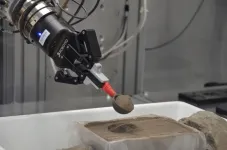(Press-News.org) There is no evidence for the commonly held belief that nut allergens can be spread through aircraft ventilation systems, say allergy and aviation medicine specialists in an evidence review published in the Archives of Disease in Childhood.
Allergen residues on surfaces, such as tray tables, and seat-back video screens, pose the main risk—a risk that is likely heightened by the fast turnaround times deployed by many low-cost carriers, they suggest.
And allergic reactions to foods are around 10 to 100 times less common during flights than they are ‘on the ground,’ they point out, although this could be due to passengers with food allergies taking more precautions when flying, they acknowledge.
Around 2–3% of children and 1–2% of adults in the UK have a food allergy, say the authors. And similar rates are observed in medium to high income countries. Food allergy is the most common cause of anaphylaxis, a potentially life threatening allergic reaction.
In a bid to dispel some of the misconceptions about the perceived risks posed to passengers with food allergies on commercial flights, the authors drew on the systematic review of the published evidence dating back to 1980, commissioned by the UK’s Civil Aviation Authority (CAA) in 2023.
With the notable exceptions of vapours from fish/seafood and exposure to occupational wheat flour, allergic reactions to aerosolised foods are rare, and rarely reproducible, say the authors.
While peanut allergens can be detected at very low levels in the air when shelling nuts, the dust settles quickly and can only be detected in very close proximity to the nuts, implying that very little dust circulates in the air.
What’s more, aircraft cabin ventilation systems are designed to circulate air across the aircraft, rather than along the cabin, so minimising the potential for spreading passenger-generated contaminants through the cabin, explain the authors.
Air is completely exchanged every 3–4 minutes during a flight. This compares with every 10 minutes for hospitals and classrooms. In modern large commercial aircraft, around half of the air intake is recirculated air that has passed through particulate air filters which effectively remove dust, vapours, microbes, and capture aerosolised food particles at the same time. The other half comes from outside.
Food proteins are often "sticky", and any unintentional exposure likely stems from surface contamination on seats, seat-back entertainment systems, and tray tables. This could be transferred from the hands either to food being eaten or directly to the mouth and/or face.
Cleaning these surfaces at the start of a flight with sanitising wipes will minimise this risk, and is “particularly important, given the minimal cabin cleaning which often occurs in between flights, especially with low-cost carriers,” highlight the authors.
Allowing food-allergic passengers to pre-board may be helpful in this respect, say the authors, who note that the US Department of Transportation already requires airlines to allow passengers with nut allergies to do this.
But announcements requesting passengers not to consume nuts during the flight are unlikely to reduce the risk of in-flight reactions, and might provide false reassurance, they add.
While many passengers with food allergies prefer to bring their own food, where an in-flight meal service is provided, most airlines offer allergen-free options, if requested in advance.
And passengers at risk of food anaphylaxis should carry adrenaline [epinephrine] auto-injectors, such as an EpiPen in their hand luggage, as these aren’t always included in onboard medical kits, nor are cabin crew always allowed to use them, advise the authors.
“There is no evidence that peanut or tree nut allergens are spread through aircraft cabin ventilation systems. Rather, the main risks are due to either failure of dietary avoidance, or allergen residues on surfaces, which can then be transferred through touch—a situation exacerbated by the very short turnaround times with many low-cost carriers,” conclude the authors.
“Airlines should have clear policies relating to food allergies which are easily available from their websites or on request. These policies should be applied consistently by both ground staff and cabin crew, in order to provide reassurance to food-allergic passengers and their caregivers,” they add.
END
Published in Molecular Psychiatry, this is the first study to suggest that the use of high potency cannabis leaves a distinct mark on DNA, providing valuable insights into the biological impact of cannabis use. High potency cannabis is defined as having Delta-9-tetrahydrocannabinol (THC) content of 10 per cent or more.
The research also showed the effect of cannabis use on DNA is different in people experiencing their first episode of psychosis compared to users who have never experienced psychosis, ...
Teleoperated robots for gathering moon dust are a step closer, according to new research by scientists at the University of Bristol.
The team were able to complete a sample collection task by controlling a virtual simulation, which then sent commands to a physical robot to mirror the simulation’s actions. They were able to do so while only monitoring the simulation - without needing physical camera streams - meaning this tool could be particularly useful for delayed teleoperation on the Moon.
Alongside a boom in lunar lander missions ...
A new world record in wireless transmission, promising faster and more reliable wireless communications, has been set by researchers from UCL.
The team successfully sent data over the air at a speed of 938 Gigabits per second (Gb/s) over a record frequency range of 5-150 Gigahertz (GHz).
This speed is up to 9,380 times faster than the best average 5G download speed in the UK, which is currently 100 Megabits per second (Mb/s) or over1. The total bandwidth of 145GHz is more than five times higher than the previous wireless transmission world record.
Typically, wireless networks transmit information using radio waves over ...
Older adults in the UK who are socially isolated are more likely to have an insufficient intake of key micronutrients such as vitamin C and vitamin B6, increasing their risk of health problems, according to a new study led by UCL (University College London) researchers.
The study, published in the journal Age and Ageing, looked at data from 3,713 people in the UK aged 50 and over who filled in a detailed questionnaire about what they ate and drank on two separate days.
The researchers found that people who were more socially isolated were more likely to have a lower than recommended intake of five micronutrients ...
Climate change has caused an increase in the semi-arid climate region in Brazil. Data from the National Center for Monitoring and Warning of Natural Disasters (CEMADEN) and the National Institute of Space Research (INPE) in the South American country indicate an expansion of 7,500 square kilometers per year since 1990, which is equivalent to five times the area of the city of São Paulo. A similar phenomenon has been observed in some regions of Europe and North Africa.
With this in mind, and with the desire to find solutions to mitigate climate change, a group ...
Copenhagen, Denmark: New data shows that the number of children suffering a seizure after swallowing medications or illegal substances has doubled between 2009 and 2023 in the US. The findings were presented today (Wednesday) at the European Emergency Medicine Congress.
The most common substances involved in these poisonings include over-the-counter antihistamines, prescription antidepressants and painkillers, and illegal synthetic cannabinoids.
Dr Conner McDonald from the University of Virginia School of Medicine told the Congress: “Seizure is one of the most severe symptoms a poisoned ...
Copenhagen, Denmark: Increases in levels of particulate matter in the air, even within World Health Organization guidelines, correspond with an increase in the number of patients going to the hospital emergency department, according to research presented at the European Emergency Medicine Congress today (Wednesday).
The study found links particularly between air pollution and cases of trauma, breathing difficulties and skin conditions.
The research was presented by Dr Andrea Rossetto an emergency medicine resident at University of Florence and Careggi University Hospital, Florence, Italy, and a PhD Student at Queen Mary University of London, UK.
Dr ...
In a teleconference with reporters on Tuesday, representatives from NASA, the National Oceanic and Atmospheric Administration (NOAA), and the international Solar Cycle Prediction Panel announced that the Sun has reached its solar maximum period, which could continue for the next year.
The solar cycle is a natural cycle the Sun goes through as it transitions between low and high magnetic activity. Roughly every 11 years, at the height of the solar cycle, the Sun’s magnetic poles flip — on Earth, that’d be like the ...
Scientists at ChristianaCare Gene Editing Institute Use CRISPR Tools to Safely Disable Gene Mutation Linked to Treatment-Resistant Melanoma
Study finds CRISPR restores the ability for cancer treatments to attack melanoma cancer cells with precision-guided gene edit that ignores healthy cells
Wilmington, DE, OCTOBER 15, 2024 -- In a potential advance for melanoma patients, researchers at ChristianaCare’s Gene Editing Institute have used CRISPR gene editing ...
A major international study has found gout is a chronic illness where genetics is a major cause, rather than lifestyle choices of the sufferer.
Led by University of Otago researchers, the genome-wide association study, published in Nature Genetics, analysed the genetic information of 2.6 million people.
Researchers analysed amalgamated DNA data sets from around the world. About three quarters of the data was from customers of 23andMe, Inc, a direct-to-consumer genetics and preventative health company, who consented to participate in research.
They found inherited genetics is an important part ...


